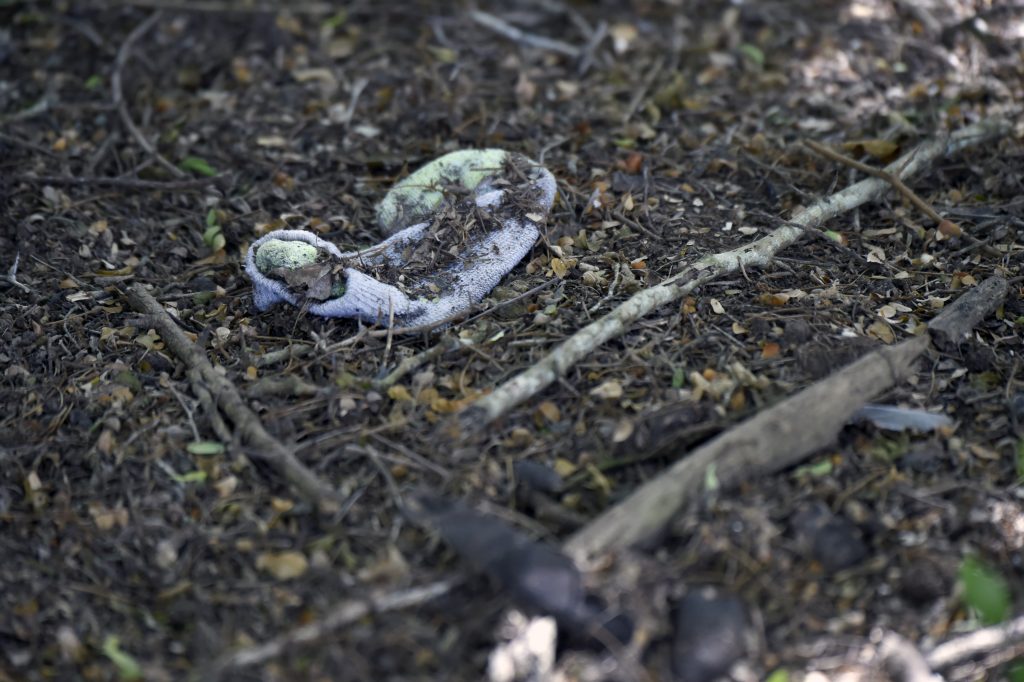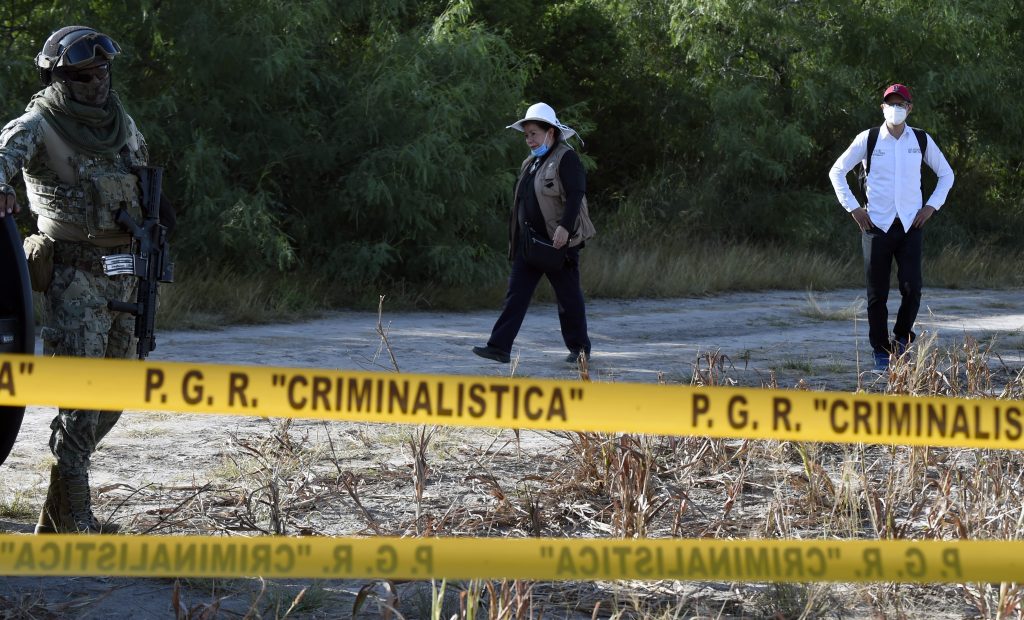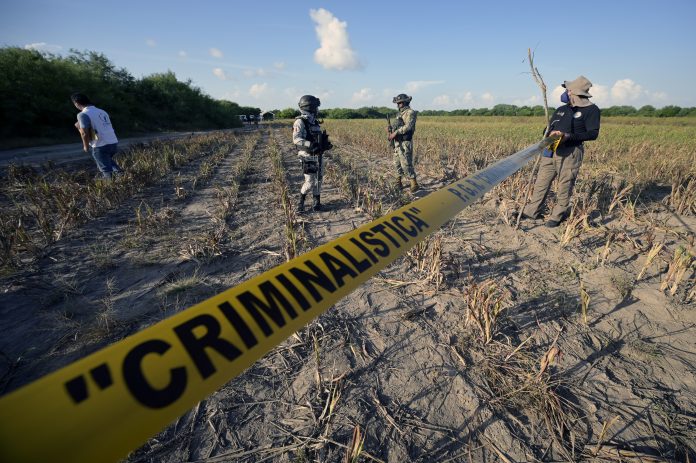A mother pleaded desperately with a soldier for a chance to find the remains of her son, one of more than 95,000 people whose disappearances haunt violence-plagued Mexico.
“I just want a bone to lay to rest beside my husband,” she said.
The woman, whose son disappeared a year ago, begged to be allowed into a former cornfield in the northeastern state of Tamaulipas where half a ton of human remains have been found since 2017.
“Answer me! Do you have children?” said the mother, in her 50s, but she received no response from the soldiers.
The site, La Bartolina, is located a few kilometers from Matamoros, a city on the border with the United States beset by violence linked to drug trafficking and other organized crime.
It is considered an “extermination camp” by the National Search Commission, the official body that coordinates the hunt for Mexico’s missing.
Access to the site is forbidden even for victims’ relatives, who often accuse the authorities of ineffectiveness and so undertake their own searches.
The mother, who did not want to be named due to concerns for her safety, has no proof that her son’s remains are at La Bartolina.
But she decided to go there after learning that other relatives would be visiting.
Crime, corruption
More than 11,800 people are registered as missing in Tamaulipas, which sits on a drug smuggling corridor. Along with the western state of Jalisco, it has seen the largest number of disappearances in Mexico.
Countrywide, 95,121 people have gone missing, according to official figures released Friday during a visit by the UN Committee on Enforced Disappearances.
During the 10 days the UN team spent in Mexico, 100 people disappeared, the committee said. It denounced what it called the ineffectiveness of the authorities, arbitrary decisions by the courts and a general culture of “impunity.”
People began to vanish during the Mexican authorities’ so-called dirty war against the revolutionary movements of the 1960s-1980s.
But it was after then-president Felipe Calderon launched a military offensive against the drug cartels in 2006 that the number of people missing — and murdered — began to soar.
Since then, the country of 126 million people has recorded 300,000 murders, including more than 36,000 in 2020 alone — an average of nearly 100 every day.
“Organized crime remains one of the main causes of disappearances,” said Laura Atuesta, an expert at the Center for Research and Teaching in Economics.
In Mexico, myriad gangs fight for control of lucrative routes for smuggling drugs, migrants and stolen fuel.
The disappearances are also a result of “corruption of police forces linked to organized crime,” Alejandro Encinas, a deputy minister responsible for human rights, said in mid-November.
The missing are mostly young people, aged 15 to 30, who are trapped in poverty — which afflicts 44 percent of the population — and unable to find work.
Others are caught in a vicious circle of gang recruitment or were simply in the wrong place at the wrong time.
In some areas, young girls fall victim to human trafficking — the theme of Mexican-Salvadoran director Tatiana Huezo’s movie “Noche de Fuego” (Prayers for the Stolen) that received a special mention in the Cannes Film Festival’s “Un Certain Regard” competition this year.

‘They’ll do nothing’
In La Bartolina, Maria Isela Valdez, who leads a group of relatives of missing persons, railed against the security forces blocking the mothers from entering the site.
“Why weren’t the National Guard, the army and the navy here when people were taken, tortured, massacred, burned and buried?” Valdez, 58, demanded.
Together with her 38-year-old daughter Delia Quiroa she was looking for her son Roberto, who was abducted in the nearby city of Reynosa in 2014.
In June 2019, Valdez knelt in front of Mexican President Andres Manuel Lopez Obrador to ask for his help.
And her daughter publicly asked the Gulf Cartel, a dominant criminal group in the area, for a truce in July to be able to enter Bartolina and find her brother’s remains.
They staged a sit-in at the prosecutor’s office before finally being allowed to visit La Bartolina.
“We’re here so that the authorities do their job, because if we leave, they’ll do nothing,” Quiroa told AFP.
On that day, the mother and daughter were permitted to wait under a tent while forensic experts did their work.
The wait was long and exhausting in temperatures of up to 40 degrees Celsius in a region where snakes slither through the undergrowth.
The experts were forced to cut short their work for the day after armed clashes broke out between gunmen and police in Matamoros.

‘Look away’
Relatives of the disappeared “continue to face a system that does not give them an answer,” National Search Commission head Karla Quintana told AFP.
In Mexico, 98 percent of crimes go unpunished and thousands of unidentified bodies linger in morgues because the justice system is overwhelmed, she said.
The country lacks forensic pathologists, and prosecutors drag their feet when it comes to investigating disappearances, Quintana said.
The authorities and others have also denounced infiltration of security organs by criminals.
Lopez Obrador’s government, in office since late 2018, says it wants to end the inertia.
Since March 2019, the National Search Commission has spent 2,300 days looking for the missing with families, Encinas said during the recent visit by the UN delegation.
Quintana — who reported in September that a second “extermination camp” had been found near Nuevo Laredo, another border town in Tamaulipas — also deplores what she said is the apathy of Mexican society.
“We do not understand how with hundreds of thousands of murders… with thousands of clandestine graves and with almost total impunity, Mexican society prefers to look away,” she recently told the Mexican edition of Spanish newspaper El Pais.
Often the reaction when people go missing is one of indifference in a society accustomed to rampant violence.
One exception was the murky disappearance of 43 teaching students on September 26, 2014 in the southern state of Guerrero. It outraged the country.
The students had commandeered buses to travel to a demonstration, but were stopped by corrupt police linked to a drug cartel.
Prosecutors initially said the cartel mistook the students for members of a rival gang and killed them before incinerating their bodies at a garbage dump and tossing the remains in a river.
But an official report presented in January 2015 by the government of then president Enrique Pena Nieto was rejected by relatives as well as independent experts from the Inter-American Commission on Human Rights.
To date, the remains of only three of the students have been identified, and the United Nations has urged the Mexican government to provide families with answers.

Killed while searching
Armed with shovels, picks and patience — and with police protection — Milagros Valenzuela searches for the remains of her brothers Marco Antonio and Alejandro near the city of Hermosillo in the northwestern state of Sonora.
It is another danger zone — in July, a member of Valenzuela’s group was shot dead in her home.
Aranza Ramos, 28, was looking for the remains of her husband Bryan, who has been missing since December 2020.
The UN Office of the High Commissioner for Human Rights (OHCHR) urged Mexico to investigate whether Ramos’s murder was linked to her search for her husband.
“When a state fails to fulfill its duty, the families of disappeared persons are placed at risk,” said OHCHR representative Guillermo Fernandez-Maldonado.
When Valenzuela saw vultures circling above one site during a search, she viewed it as a sign that there were human remains there.
But before she could reach the site, armed clashes broke out nearby, leaving four people dead.
Every week Valenzuela’s group meets at a gas station in Hermosillo.
For one member, whose son has been missing for four years, the camaraderie of their days together is a kind of therapy.
But the good spirits quickly give way to frustration.
“The hardest thing (is) starting off hopeful of finding something and returning empty-handed,” said Valenzuela, 21.
Her group publicly asks criminals not to dispose of the bodies.
“If you already took their lives, why do you bury them? Why do you burn them?”
But she knows the answer.
“Unfortunately, the authorities say that without a body there’s no crime,” she said.
Prosecutors in Sonora defended their record, saying that they had supported relatives’ efforts.
The state attorney general is committed to “support families looking for a loved one in their remarkable work,” a prosecution spokeswoman told AFP.
Despite the dangers, Anel Robles, a member of Valenzuela’s group, is determined to keep looking for her husband, who disappeared while in police custody.
“If we don’t look for them, who will?” she said.









